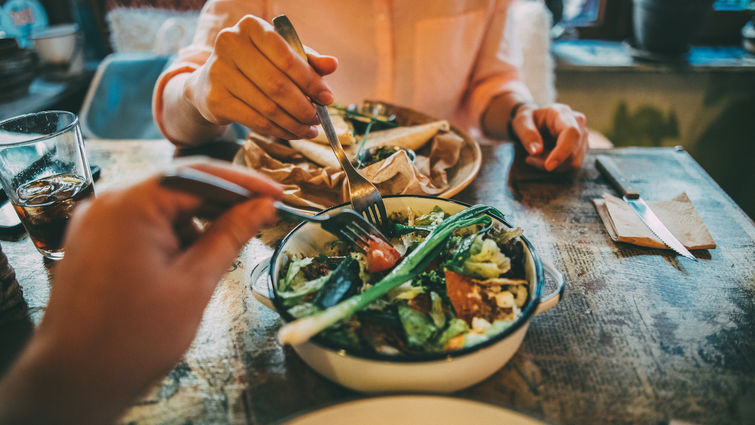
Eating healthy doesn’t come easy to everyone, and it shouldn’t make anyone feel trapped in their own kitchen. Dining out is often necessary due to travel, busy schedules or simply to unwind and reconnect with friends or family. It’s also an opportunity to have more choices when it comes to food.
Learning how to make healthier choices away from home is a key step to practicing a balanced lifestyle that is sustainable, says Jason Holden, M.Ed., R.D., C.D.E., a registered dietitian at Loma Linda University Health.
Holden says dining out can even be a part of a healthy lifestyle. He offers these 10 tips to eat healthier while dining out:
- Plan Ahead. Most restaurants have menus with nutritional information online. Looking at this ahead of time will help you choose satisfying food that also aligns with your health goals.
- Don’t show up “hangry.” Really hungry can turn into really angry really fast. This extreme hunger can encourage snacking on empty calorie foods such as chips or bread and will likely cause overeating. Nourish the body with healthy snacks one to two hours prior to going out and drink plenty of water before the meal.
- Skip the bread basket or chips. Although enticing, these empty caloric foods offer little to no nutritional value.
- Dissect the menu. When reading the menu, look for words like grilled, poached, steamed and baked. These items tend to have less butter and oil. Try to avoid foods that are breaded, crispy, cheesy, crusted and, of course, fried.
- Don’t be afraid to make special requests. Most restaurants can customize menu options to meet dietary needs. Swap out sauces and side dishes for healthier options. Ask for grilled instead of fried or request sauces on the side. “Just remember to be reasonable with your requests,” Holden says.
- Slow down and enjoy. Eat slow and savor the food. Put the fork down between bites, and enjoy the atmosphere and conversation of company.
- Master your portions. Most restaurant portions these days are enough for at least two people. Share a plate, order a la carte, or request a to-go box and pack up half the meal before eating.
- Skip the sugary beverage. A "medium" soda, sweet tea or lemonade can have up to 16 teaspoons of sugar. Water is always the best beverage option, but unsweetened iced tea is a good alternative. Some restaurants even offer waters infused with fruit to add a little flair to your H2O.
- Watch out for the Halo effect. Be cautious of the fancy, self-proclaimed “healthy” restaurants. Their menu items can also be loaded with calories, fat or sugar. “Be aware of words like natural, organic, vegan etc. — that often does not translate to healthy,” Holden says.
- Be kind to yourself. “Be the best you can be,” Holden says. Food is mostly fuel but it’s OK to sometimes have “fun” food. “Occasional indulgences are not going to ruin your overall health goals. Just slow down and appreciate your food.”
At the end of the day, Holden recommends to keep in mind the common components of a healthy diet: a lot of fruits and veggies, whole grains, lean protein, low fat dairy or high calcium plant foods (unsweetened soy or almond milk, calcium fortified tofu, sesame seeds, and certain green leafy vegetables), and healthy fats from nuts, seeds, and avocado. And, of course, limit the junk.
Holden is a registered dietitian who works primarily with bariatric surgery patients at Loma Linda University Health. For more information, call 909-651-7091.
